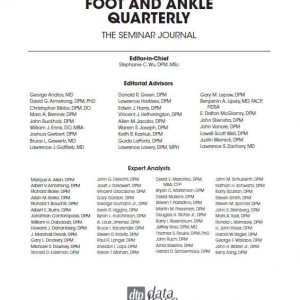33-3 Exploring the Impact of Artificial Intelligence on Care Delivery
$88.00
In This Issue:
- FEATURE ARTICLE: Is Machine Learning Poised to Replace Current Prognostic Indicators for Predicting Wound Trajectory?
Windy Cole, DPM, CWSP - CONDENSATIONS and COMMENTARIES
- An Explainable Machine Learning Model for Predicting In-Hospital Amputation Rate of Patients with Diabetic Foot Ulcer
Commentary by Alton R. Johnson, Jr., DPM, Brennen O’Dell, DPM and Kanika Kochar, DPM - A Machine Learning Model for Early Detection of Diabetic Foot Using Thermogram Images
Commentary by Frank Aviles, PT - Machine Learning and Smart Devices for Diabetes Management: Systematic Review
Commentary by Anthony Tickner, DPM - Toward Machine-Learning-Based Decision Support in Diabetes Care: A Risk Stratification Study on Diabetic Foot Ulcer and Amputation
Commentary by Robert J. Klein, DPM - A Machine Learning Approach to Predicting Diabetes Complications
Commentary by Robert J. Snyder, DPM - Evaluation of Machine Learning Methodology for the Prediction of Healthcare Resource Utilization and Healthcare Costs in Patients with Critical Limb Ischemia: Is Preventative and Personalized Approach on the Horizon?
Commentary by Minghsun Liu, MD, PhD - Utilization of Smartphone and Tablet Camera Photographs to Predict Healing of Diabetes-Related Foot Ulcers
Commentary by Cyaandi Dove, DPM - Predication of Diabetic Sensorimotor Polyneuropathy Using Machine Learning Techniques
Commentary by Valerie L. Marmolejo, DPM, MS, MWC - Prediction and Diagnosis of Venous Thromboembolism Using Artificial Intelligence Approaches: A Systematic Review and Meta-Analysis
Commentary by Barbara Aung, DPM - Development of a Method for Clinical Evaluation of Artificial Intelligence-Based Digital Wound Assessment Tools
Commentary by Eric J. Lullove, DPM
- An Explainable Machine Learning Model for Predicting In-Hospital Amputation Rate of Patients with Diabetic Foot Ulcer
- AUDIO LECTURE 1: The Role of Artificial Intelligence in Wound Care
Windy Cole, DPM, CWSP - AUDIO LECTURE 2: Angiosome Concept: Paradigm Shift in Evaluating and Treating Vascular Disease
Robert J. Snyder, DPM, CWSP - CONTINUING EDUCATION QUESTIONNAIRE
Description
EDITORIAL
The idea that machines can “think” and simulate human behavior has been around since the 1950s. Artificial Intelligence (AI) is a broad term used to describe the application of computers to simulate intelligent behavior and critical thinking. The field of AI has continued to grow and evolve as the power and ability of computers has expanded. Today, AI is integrated into our daily routines by way of smart phones, computer assistants, and gaming systems among countless other things. Incorporating AI into medicine has the potential to support better and more precise care delivery, producing improved patient outcomes. This edition of FAQ will provide a wide overview of AI in podiatry and wound care, as we also examine the current status of AI in medicine, its utility in different disciplines and its future applications.
We appear to be on the verge of a sea change in the practice of medicine. Medical professionals have a need to understand and acclimate to these advances to support better healthcare delivery to the population served. It is my hope that you find the information in this issue of FAQ illuminating and enlightening. It has been my great pleasure to work with the contributing authors to bring this project to fruition.
Stay well,
Windy Cole, DPM, CWSP
Related products
-

33-4 Trauma of the Foot and Ankle
$88.00 Add to cart -

33-2 Podiatry and Medicine in the Age of Social Media
$88.00 Add to cart -
Sale!

Volume 33 – Complete – Four Issues
$298.00Original price was: $298.00.$260.00Current price is: $260.00. Add to cart -

33-1 Managing and Monitoring the Physical Activity of Patients with Diabetic Foot Disease
$88.00 Add to cart

